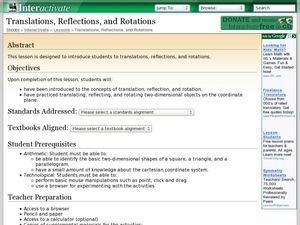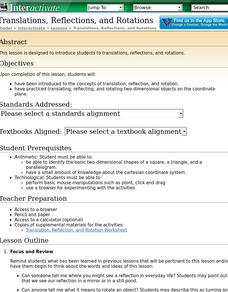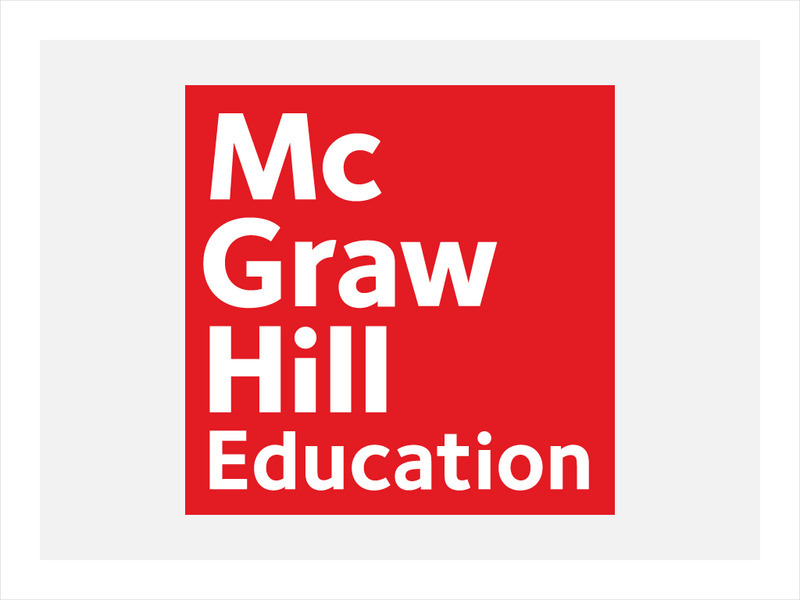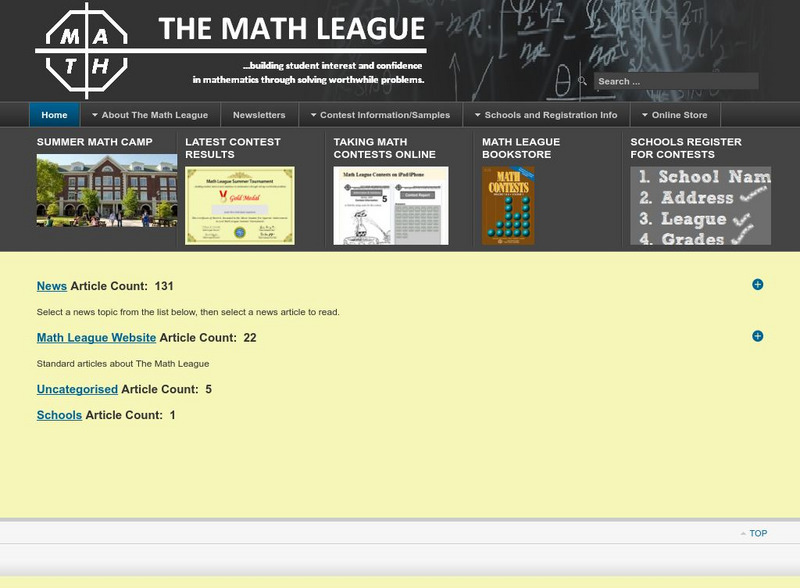Curated OER
Angle Exploration and Classification
Students compare and contrast angles and identify them as acute, obtuse, right, or straight angles. They create rays and angles using uncooked spaghetti, read and discuss key vocabulary terms, and complete a variety of geometry worksheets.
Curated OER
The Truth About Triangles And Proofs
Learners engage in a lesson that is about the classification of triangles and the mathematical proofs involved in working with them. They work on a variety of problems that are created by the teacher with the focus upon the importance of...
Curated OER
Translations, Reflections and Rotations
Fifth graders use the Internet to learn about translations, reflections and rotations. Students access the Transmographer program on the Internet, where they practice what they have learned. Students also complete a worksheet.
Curated OER
Geometry: Tessellations
Students create tessellations with computer software while applying their knowledge of reflections, rotations, and translations.
Curated OER
Parallel and Perpendicular Lines
Tenth graders explore parallel and perpendicular lines. In this geometry lesson, 10th graders investigate the relationships associated with parallel lines and transversals, perpendicular lines, and the angles formed by these lines. ...
Curated OER
Dilations of 2 and 3 dimentional figures and their effect on area, surface area, and volume.
Seventh graders investigate the area and volume of 2D and 3D figures. In this geometry lesson, 7th graders create a storyboard explaining their knowledge of 2D and 3D shapes. They analyze their data and interpret their results.
Curated OER
Dilations- What a Stretch!
High schoolers perform dilation on various geometric shapes. They also discuss pros and cons of dilation and employ the Frayer Model to study the vocabulary words in this section.
Curated OER
An Introduction to Quadrilaterals
Students explore different types of quadrilaterals. Students define the terminology used with quadrilaterals. They create particular quadrilaterals based on specific characteristics of the quadrilaterals using an online tool.
Curated OER
Translations, Reflections, and Rotations
Tenth graders have been introduced to the concepts of translation, reflection, and rotation, and have practiced translating, reflecting, and rotating two-dimensional objects on the coordinate plane.
Curated OER
Teaching the Bell Tetrahedral Kite
Students complete readings on kite making and kite flying. They analyze how the parts of a system interconnect and influence each other. Students identifies and uses color and form in a 3D artwork.
McGraw Hill
Mc Graw Hill: Glencoe: Self Check Quizzes: Congruent and Similar Figures
Use Glencoe's randomly generated self-checking quiz to test your knowledge of congruent and similar figures. Each question has a "Hint" link to help. Choose the correct answer for each problem. At the bottom of the page click the "Check...
CK-12 Foundation
Ck 12: Geometry: Corresponding Parts of Congruent Figures
[Free Registration/Login may be required to access all resource tools.] In this lesson, students identify corresponding parts of congruent figures. They examine guided notes, review guided practice, watch instructional videos, and...
Khan Academy
Khan Academy: Use Similar & Congruent Triangles
Solve geometry problems with various polygons by using all you know about similarity and congruence.
Khan Academy
Khan Academy: Similarity and Transformations
Given two polygons, try to map one onto the other using angle-preserving transformations, and determine whether they are similar. Transformations are done in "intuitive mode." Students receive immediate feedback and have the opportunity...
The Math League
The Math League: Similar Figures
This tutorial explains what similar figures are in geometry and provides examples.
CK-12 Foundation
Ck 12: Geometry: Perimeter and Area Study Guide
[Free Registration/Login may be required to access all resource tools.] This study guide looks at the definitions and units for perimeter, area, and circumference, and at the perimeter and area of different shapes, including regular...
Alabama Learning Exchange
Alex: Tan Ii
The Chinese character mark for Tan II (pronounced she-tow-bah) is the second of two lessons to introduce first grade students to geometry using tangrams. This lesson incorporates history, math, and language arts. In this lesson students...


















